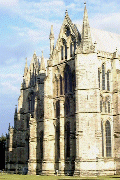THE PRESENT CATHEDRAL
THE EXTERIOR

 Salisbury Cathedral is generally ranked as the finest example of Early English Gothic
architecture in Britain and was built over a period of only 38 years.
The best view of the exterior is to be obtained from the
north-east corner of the close from where the outline of the church is brocken, not
by pinnacles and buttresses, but by the two transepts and the tall spire (which
is the tallest in Britain) to which the eye is led by the pyramidal outline. Despite
the lightness and graceof the structure, it also possesses a distinctive granduer.
Salisbury Cathedral is generally ranked as the finest example of Early English Gothic
architecture in Britain and was built over a period of only 38 years.
The best view of the exterior is to be obtained from the
north-east corner of the close from where the outline of the church is brocken, not
by pinnacles and buttresses, but by the two transepts and the tall spire (which
is the tallest in Britain) to which the eye is led by the pyramidal outline. Despite
the lightness and graceof the structure, it also possesses a distinctive granduer.
THE PRESENT CATHEDRAL: THE EXTERIOR
THE SPIRE
The gracefull spire rises 123 metres (200 feet) above the battlements of the tower which are themselves 212 feet above the ground making this the tallest spire in England with an overall height of 404 feet. It is decorated with bands of stone.
It was at one time believed that the spire was built between 1310 and 1330 around the massive oak scaffolding which is found within the structure. Dendochronological examination of the oak timbers in 2004 has revealed that the structure was originally built without the heavy internal scaffolding which is now thought to have been added to reinforce the spire after the great storm of 1362.
The original builders of the cathedral had no plans to crown the edifice which such a
grand structure and the four Purbeck marble columns of the spire crossing were intended
only to support a small lantern tower.
It was with great temerity that the builders of 1330 added hundreds of
tons to the piers which supported the tower. Every effort was made to make the
addition as light as possible and flying buttresses and stariner arches were added both
inside and outside the cathedral to take the additional load. Their efforts have proved
to be largely successfull for despite the visible bending and the displacement of the
pinnacle by 75 cm to the south-west (shown by the markings on the floor of the spire
crossing), no displacement of the structure has taken place since
Sir Christopher Wren inspected it in 1668.
THE PRESENT CATHEDRAL: Interior
THE NORTH TRANSEPT
The north window, although 13th century in style, was made in 1895 and the three oak
screens were carved by the cathedral craftsmen between 1988 and 1995. The Chapel of
St Edmund and St Thomas reflects the links of the Diocese with the Sudan.
On the west wall, the well-worded inscription under the bust of the naturalist
Richard Jefferies (1848-87) describes him as one who;-
|
...observing the works of Almighty God with the poet's eye has
enriched the literature of his country and won for himself a place amongst those
who have made men happier and wiser.
|
On the north wall is the monument of Bishop Blythe (1494-99) and the Wiltshire historian
Sir Richard Colt Hoare. The transept also contains three monuments by Flaxman and
Chantrey's monument to the Earl of Malmesbury.

